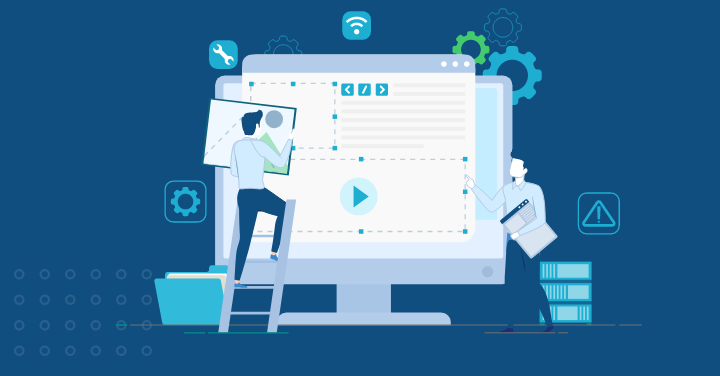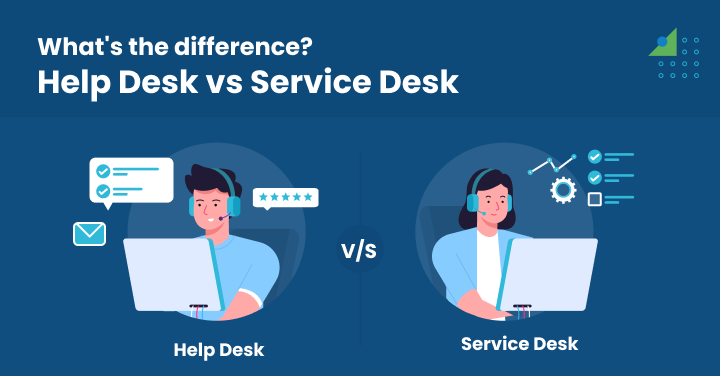Digital transformation has become a buzzword in the business world, and for good reason.
As organizations adapt to the digital age, it is crucial for them to embrace new technologies and strategies to stay competitive.
One area where digital transformation is making a significant impact is in service desks.
In this blog, we will explore the of digital transformation in service desks, the relationship between digital transformation and service desks, how service desks contribute to digital transformation, KPIS and benefits.
Let’s dive in and discover the service desk essentials in the era of digital transformation.
Understanding Digital Transformation and its Impact on Service Desks
Digital transformation refers to the integration of digital technologies into all aspects of an organization, fundamentally changing how it operates and delivers value to customers.
This transformation has a profound impact on service desks, which are responsible for managing IT incidents, service requests, and supporting employees and customers alike.
The digital transformation in service desks involves leveraging new technologies, processes, and strategies to improve service delivery, enhance customer and employee experiences, and drive operational efficiency.
The Relationship between Digital Transformation and Service Desks
Digital transformation and service desks have a close relationship, as service desks play a crucial role in supporting business needs during the transformation journey.
As organizations undergo digital transformation, their IT service desk becomes an integral part of the digital infrastructure, aligning service management with digital transformation goals.
Service desks streamline service requests, incident management, and support, ensuring business continuity and customer satisfaction.
In the digital era, service desks evolve to meet new challenges, enhance employee support, and drive operational efficiency, ultimately contributing to the overall success of digital transformation initiatives.
How Service Desks Contribute to Digital Transformation
Service desks not only adapt to digital transformation, but they also actively contribute to it.
They act as a catalyst for digital transformation by improving customer service, enhancing employee experience, and providing essential support for enterprise service management.
Let’s explore how service desks contribute to digital transformation and help organizations stay ahead in the digital era.
Improving Customer Service through Digital Transformation
Digital transformation brings new opportunities for service desks to enhance customer service.
With the help of digital technologies, service desks can provide personalized customer support, backed by knowledge base automation, conversational AI, and self-service options.
Embracing digital transformation allows service desks to capture and analyze service desk metrics, leveraging data to improve customer satisfaction, responsiveness, and support.
By harnessing digital technologies, service desks are better equipped to deliver exceptional customer service, which is vital for businesses to thrive in the digital age.
Digital transformation enhances customer support with AI technologies, automating repetitive tasks while delivering personalized user experiences.
Service desk metrics, such as first contact resolution rate, help measure customer satisfaction and optimize support processes.
Digital transformation allows service desks to offer self-service options, knowledge base automation, and intelligent automation, all contributing to improved customer support.
By evolving service desk operations, businesses can foster a new mindset focused on customer experience and satisfaction.
Digital transformation empowers service desk agents, enabling them to deliver exceptional customer service and contribute to business success.
Key Benefits of Service Desk Software
Below are five reasons why enterprises should implement service desk software:
1. Seamlessly align IT with business processes:
Service desks enhance collaboration and communication between IT and other business departments.
The service desk software assists in the resolution and even evasion of preventable issues and breakdowns by helping in creating, assigning, tracking, and resolving tickets.
2. Increase operational efficiency:
Most service desk software follows ITIL guidelines to offer standardized processes.
These processes help in simplifying IT operations, allowing for improved IT strategy planning, and tracking.
Moreover, IT teams can set up usable, innovative workflows through the service desk to automate repetitive tasks to improve efficiency.
3. Make data-driven decisions:
Service desks gather and retain data from issues, products, and performance outcomes.
This vast library of information stored in the software’s knowledge base can not only help customers, businesses, and employees save time and effort if similar future issues arise but also makes it easier to analyze and make better IT decisions.
4. Boost productivity:
Incorporating some of the automated features of a service desk software allows IT teams to complete work faster and more easily.
For example, the auto-ticket routing feature automatically categorizes, prioritizes, and assigns tickets to the right IT personnel based on their workload, ensuring that IT teams do not waste time managing tickets.
5. Improve asset management:
A service desk serves as a central repository for all the organization’s hardware and software assets, as well as any applicable contracts, allowing for quick information retrieval, asset assessment, configuration, and maintenance, among other things.
How will Service Desk help in Digital Transformation?
IT service desk software can enable the following critical functions as businesses begin their digital transformation journey for better customer experience management:
1. Using scalable operations to replace spreadsheet and email-based processes
When most businesses expand, they develop operational procedures supported by basic tools like email and spreadsheets.
As businesses begin their digital transformation, they have a chance to replace elementary procedures with service-desk operations that use automation, data management, and modern tools to offer reliable and quantifiable results.
2. Providing resources to users
To enable employees, whether remote or not, to access the organization’s technological resources while maintaining suitable security controls, the organization must implement formal processes for providing access to technology and data resources.
Although automation and orchestration capabilities frequently manage the majority of provisioning requests, there may be existing exceptions and tasks that have not yet been automated.
Using a service desk to manage and automate these activities ensures consistency of services and enhanced customer experience.
3. Assisting in the resolution of incidents that impact business processes
When an IT incident occurs or a change is planned, it almost always has far-reaching consequences throughout the organization.
During a business-impacting incident, the service desk can undertake critical functions such as ticket triaging, assessment of impact, troubleshooting activities, and communication coordination.
4. Monitoring the performance of system and process
With its combination of humans, technology, and data, digital business processes have numerous variables that must all function together to generate successful outcomes.
Service desks are ideal areas for monitoring the performance of these processes and systems for early warning signals of any IT issues.
5. Resolving data issues to gather insights
Management in any digital organization must be confident in the informational insights provided by IT systems to make decisions. Data quality issues cause the bulk of errors in digital operations.
Utilizing service desk processes for incident and problem management can help organizations identify the root cause of these problems, enabling them to prevent such issues in the future.
What are the Key KPIs for Enterprises to Focus On?
Now that we have established the business-augmenting potential of the service desk in the digital transformation of enterprises, it’s time to explore some service desk KPIs for digital transformation that enterprises should focus on.
1. Tickets by status
By regularly monitoring the statuses of service desk tickets – new, open, pending, on-hold, solved, or closed, the overall performance and responsiveness of service desk operations can be tracked and measured.
This helps make critical improvements and provides internal support that can significantly boost customer satisfaction levels.
2. Support tickets by channel
There are more customer touchpoints than ever before in today’s hyper-connected digital world and delivering consistent performance across all the channels is critical to maintaining customer experience quality.
So, tracking how many customer requests come across each channel can prove to be invaluable for any organization in improving overall support levels as well as determining which touchpoints require the most investment or attention at any given time.
3. First contact resolution rate
The first contact resolution rate (FCR) is the % of tickets resolved by the support team at the first point of contact.
Addressing the customers’ concerns with fewer steps or follow-ups can enhance the service desk team’s efficiency and customer satisfaction levels dramatically.
Considering support teams must manage numerous channels and touchpoints in the digital era, identifying emerging patterns and developing informed strategies by analyzing first contact resolution based on various issues can increase first contact resolution consistently.
4. Average resolution time
Customers want their issues to be resolved as soon as possible. Customer satisfaction ratings can be hampered by tickets that take too long to resolve.
Even the service desk team suffers if there are too many open tickets and disgruntled customers so the service desk team’s constant objective should be to reduce the amount of time it takes to resolve an issue.
5. Cost per incident
Insights into overall efficiency instabilities can be obtained by evaluating the cost of staff time and resources used per incident including overtime.
This identifies trouble areas where the service desk may be wasting money without recognizing it, allowing management to find cost-cutting alternatives.
6. Agent utilization rate
Agent utilization rate, also known as occupancy rate, can help track the entire support team’s workload as well as the output of individual team members with complete precision.
The utilization rate can provide a clear picture of what proportion of time the team spends on true support-centric activities.
If there is a lag indicated in utilization, team managers can quickly diagnose the issue, provide training, or change their approach as needed.
7. Customer satisfaction
The fact of the matter is that retaining existing customers is less expensive than acquiring new ones, and industry data suggests that they are worth three times as much as a potential prospect.
So the customer satisfaction score (CSAT) is particularly useful since it provides a quick snapshot of the customers’ overall satisfaction levels over time.
The customer satisfaction score (CSAT), which is commonly calculated on a scale of 1-5, can be used to measure how the customers view an organization’s approach to support.
To increase the CSAT score, support teams must ensure timely responses and decrease average resolution times.
Conclusion:
How Service Desk Helps Enterprises Achieve High KPIs by Completes Disruptive Technologies
Customers have the upper hand when it comes to service because they are the ones who get to set the terms of interaction.
Due to this, organizations are welcoming digital transformation since it enables them to customize their strategy for their specific customer base.
If your organization wants to gain a competitive edge through the service desk, you must start thinking digitally.
Going digital can provide you access to a variety of information about your customer’s challenges, issues, and concerns, that you can utilize to support them effectively.
Hopefully, this blog has helped you understand some of the ways you can make your digital transformation successful with a service desk.
Motadata ServiceOps provides a robust IT service desk that includes a built-in reporting module and customizable widgets.
These features allow you to track various service desk metrics seamlessly.
Additionally, the platform offers intelligent automation features and follows ITIL-aligned service desk processes.
Begin your digital transformation journey with Motadata ServiceOps 30-day free trial.
FAQs:
The service desk acts as the primary support hub, ensuring smooth adoption of new technologies and enhanced user experiences.
It provides continuous IT support, manages incidents, and ensures minimal disruptions during technology transitions.
By offering 24/7 support and monitoring services to prevent downtime.






